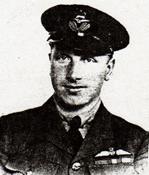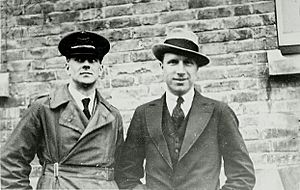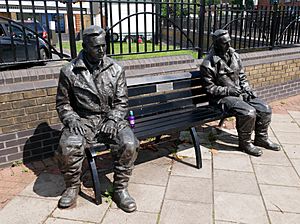John Alcock (RAF officer) facts for kids
Quick facts for kids
John Alcock
|
|
|---|---|
 |
|
| Born | 5 November 1892 Seymour Grove, Stretford, England, |
| Died | 19 December 1919 (aged 27) Cottévrard, near Rouen, Normandy, France |
| Buried |
Southern Cemetery, Manchester
|
| Allegiance | United Kingdom |
| Service/ |
Royal Navy (Royal Naval Air Service), Royal Air Force |
| Years of service | 1914–1919 |
| Rank | Captain |
| Awards | Order of the British Empire Distinguished Service Cross Britannia Trophy (posthumous) |
Sir John William Alcock (born November 5, 1892 – died December 19, 1919) was a brave British pilot. He was famous for flying the first non-stop flight across the Atlantic Ocean! In June 1919, he and his navigator, Arthur Whitten Brown, flew from Newfoundland to Clifden, Ireland. John Alcock was an officer in the Royal Navy and later the Royal Air Force. Sadly, he died in a flying accident in France later that same year.
Contents
Early Life and Learning to Fly
John Alcock was born on November 5, 1892, in Stretford, England. He became interested in flying when he was about 17 years old. His first job was at a motor company in Manchester. There, he met people who loved airplanes, like Charles Fletcher and Norman Crossland. He also met Maurice Ducrocq, a French pilot.
Ducrocq hired John as a mechanic at an airfield called Brooklands in Surrey. This is where John learned to fly! He earned his pilot's license in November 1912. After that, he became a racing pilot for the Sunbeam Motor Car Company. By 1914, he was good enough to compete in air races.
John Alcock's Military Adventures
When World War I began, John Alcock joined the Royal Naval Air Service. He started as a flight instructor in Kent. In December 1915, he became an officer. In 1916, he moved to a squadron on the Greek island of Lemnos. While there, he even designed and built his own fighter plane, called the Alcock Scout. He made it from parts of old planes!
On September 30, 1917, John Alcock showed great bravery. He was flying a Sopwith Camel plane when he attacked three enemy aircraft. He forced two of them to crash into the sea! For this brave act, he received the Distinguished Service Cross.
Later, he flew a large bomber plane on a mission to attack Constantinople. One of his engines stopped working near Gallipoli. He had to fly over 60 miles on just one engine. Then, that engine also failed! His plane crashed into the sea. John and his two crew members swam for an hour to reach the shore. They were then captured by Turkish forces and became prisoners of war. John stayed a prisoner until the war ended in November 1918. He left the Royal Air Force in March 1919.
First Non-Stop Flight Across the Atlantic Ocean

After the war, John Alcock became a test pilot for a company called Vickers. He decided to try to be the first person to fly non-stop across the Atlantic Ocean. This was a huge challenge!
On June 14, 1919, John Alcock and his navigator, Arthur Whitten Brown, took off from St John's, Newfoundland. They flew in a special Vickers Vimy bomber plane. Their flight was very difficult because of bad weather. They faced strong winds, fog, and even ice on the wings! Their instruments sometimes stopped working, making it hard to know where they were going.
After 16 hours and 12 minutes, they landed in a bog (a marshy area) near Clifden, Ireland, on June 15, 1919. They had flown about 1,980 miles (3,187 kilometers)! This amazing flight won them a £10,000 prize from the Daily Mail newspaper.
A few days later, King George V honored both Alcock and Brown. He made them Knights Commanders of the Order of the British Empire at Windsor Castle. This meant they were now "Sir" John Alcock and "Sir" Arthur Brown.
A Sad End
On December 18, 1919, Sir John Alcock was flying a new Vickers plane to an exhibition in Paris. He crashed in thick fog near Rouen, France. He was badly hurt and sadly died the next day.
His grave is in Southern Cemetery, Manchester, marked by a large stone.
Awards and Special Recognitions

- Distinguished Service Cross: He received this award on December 19, 1917. It was for his "great skill, judgment and dash" in attacking enemy planes on September 30, 1917.
- Knight Commander of the Order of the British Empire: He was given this honor on June 27, 1919. It was to celebrate his "distinguished services to Aviation" for the successful flight across the Atlantic.
See also
- Transatlantic flight

